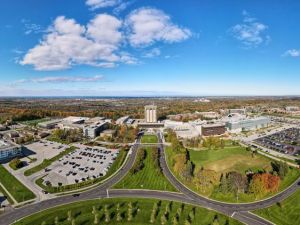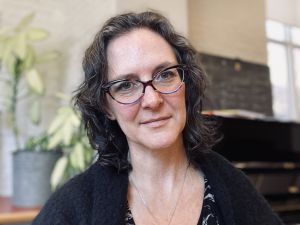 Brock University PhD student Jeremia Coish, left, and Associate Professor of Health Sciences Adam MacNeil work in BrockUniversity’s Level 3 containment laboratory. Photo by Mariana Garrido de Castro.
Brock University PhD student Jeremia Coish, left, and Associate Professor of Health Sciences Adam MacNeil work in BrockUniversity’s Level 3 containment laboratory. Photo by Mariana Garrido de Castro.NOTE: This is one in a series of articles published by The Brock News to mark the one-year anniversary of Brock University suspending in-person, on-campus classes due to the COVID-19 pandemic. To read all of the articles in the series, click here.
If there’s one illustration that best captures COVID-19’s impact on research activities and output at Brock University over the past year, it would be the shape of a ‘U’.
It’s an analogy Michelle McGinn, Associate Vice-President, Research uses to describe the ebb and flow of research activities for many scholars around the world, including at Brock.
The initial weeks following the dramatic March 13, 2020 announcement of the suspension of in-person classes and labs saw a flurry of research papers being written, says McGinn.
“In the early phases, many people had activities they could be working on from data collected earlier,” she says. “They had those papers they hadn’t finished off, they no longer had to fly off to international conferences, since those had been cancelled. It created a bit of a window for writing before they needed access to new data.”
Some laboratory teams that couldn’t access their facilities in early days took the opportunity to conduct extensive literature reviews and think of broader questions around their experiments.
A number of researchers, particularly in the social sciences, modified their existing projects or created new ones to investigate the impacts of COVID-19, especially on children and families, through online interviews and questionnaires.
“Many community members were home and had fewer activities in their lives in the first months, so they were available to respond to those research invitations,” says McGinn.
With increasing clarity around public health advice and sector practices, spring and summer 2020 saw increased access to research activities and facilities. Brock’s Research Access Task Force, which McGinn chairs, consulted faculty and student researchers on principles, priorities and needs, in order to formulate the first major campus access plan after the March closure.
As a result, researchers had greater access to most lab facilities and research participants were allowed on campus.
“Right from start of the pandemic, Brock scholars and graduate students worked to find ways of adapting to reduced access to facilities, and to many challenges they faced under unprecedented circumstances,” says Brock’s Vice-President, Research Tim Kenyon.
In addition to co-ordinating research logistics, the Office of the Vice-President, Research focused on mitigating the gaps, stresses and uncertainties reported by researchers.
“The University created a series of funds and programs that help to alleviate time constraints, enable research training for students, ensure that safety protocols are known and supported, and provide access to personal protective equipment,” he says.
Examples of some of these supports include:
- Automatic, one-year extensions for all internal grant programs
- A dedicated webpage to compile the many COVID-related updates from funding agencies
- The special VPR Research Training Award that supported research internships for 42 students in summer 2020
- Safety training and new advanced PPE equipment for researchers working in Brock’s CL3 lab
- Matching fund support for submissions to COVID-focused special programs from CIHR, NSERC and SSHRC
In partnership with the President and Provost, the Office of the VPR also supported an emergency pandemic funding program for students that launched in April, 2020.
The latter part of 2020 saw announcements of Brock researchers receiving grants from special COVID funds offered by the Canadian Institutes of Health Research (CIHR), Canada Foundation for Innovation, Natural Sciences and Engineering Research Council of Canada (NSERC), and Social Sciences and Humanities Research Council of Canada (SSHRC), among others.
While many projects were thriving, others were slowed or put on hold. McGinn says the challenges differed across research fields. Lab access opened up in June for many bench scientists. However, the 18 square metres per person requirement was difficult in labs where several teams shared the same space and equipment.
“When you have 14 faculty researchers plus all of their students, it’s a much more complicated scheduling problem, which adds a whole other layer,” she says, adding that facilities were available from 8 a.m. to 8 p.m. daily.
Scholars who needed access to library resources faced different obstacles.
“Those who rely upon archival materials have been particularly hampered, whether it is Brock’s archive or some archive that requires travel,” says McGinn. “Some have critical documents on microfilm, but no access to a reader to actually use those materials.”
Interlibrary loan for print materials has just relaunched this week.
“Everyone who couldn’t do their research from home has had to request access,” says McGinn. “That added an extra review process: putting together an application, identifying research that can be safely implemented, mitigate any risks, so that was new work that they had to do, and other people had to review that.”
On top of these struggles, many researchers had to also re-design their courses for online delivery. Faculty with young children at home had to balance homeschooling with their tasks. By the end of the year, burnout and exhaustion — and a provincewide stay-at-home-order — had slowed things down.
But with Brock entering Stage 2, Niagara going into the Red zone, and warm spring-like weather approaching, there is a sense that research at Brock is on the upswing, says McGinn.
Facilities are slowly opening, research participants will be allowed back on campus, and many research programs will resume with a renewed energy, she says.
McGinn, who is Brock’s representative on the Ontario Council on University Research’s COVID-19 Research Working Group, says this U-shaped pattern she’s observed at Brock is similar to the situation in other universities.
She notes how she and her colleagues, both within Brock and the wider provincial group, have formed policies and programs by “sorting through all types of complexities and drawing upon all kinds of expertise as none of us had expertise with this virus or how to handle a disruption of this scale. We’ve been learning all these kinds of things collectively.”
Kenyon says, throughout it all, research has remained strong and steady at Brock. Many researchers have brought their expertise to bear on pandemic-related problems, and have contributed insight and advice to the broader public as well.
“I want to acknowledge our scholars and students for the tenacity and innovation they’ve shown as they continue to produce world-class research that makes a real difference in people’s lives,” he says.











